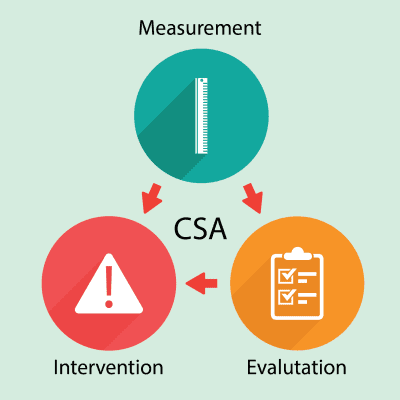What is CSA?
There are more than 500 million trucks and bus carriers in the US and the Federal Motor Carrier Safety Administration (FMCSA) does its best to execute safety regulations for all of them. In 2010, the FMCSA launched the Compliance, Safety, and Accountability (CSA) initiative to improve large truck and bus safety. The measure was intended to reduce crashes and injuries and better report safety problems.
CSA is a compliance model that permits the FMCSA to gather large amounts of safety performance and equipment maintenance data. They can then contact carriers to point out areas of concern to prevent accidents.
How does CSA work?
The CSA enforcement and compliance process consists of 3 main stages: measurement, evaluation and intervention.
- Measurement
Using data on crashes and inspections, CSA identifies carrier’s or driver’s safety problems and monitors how they are being resolved. There are 7 Behavioral Analysis Safety Improvement Categories (BASICs):
- Unsafe Driving (e.g. speeding, inattention, reckless driving)
- Hours of Service Compliance (e.g. operating a CMV while ill or fatigued)
- Driver Fitness (e.g. driver is medically unqualified to operate a truck)
- Controlled Substances/Alcohol (use or possession)
- Vehicle Maintenance (failure to properly maintain truck, e.g. light or brake defects)
- Hazardous Materials Compliance (unsafe handling, absence of shipping papers)
- Crash Indicator (based on number and severity of crashes)
- Evaluation
After the measurement stage, FMCSA contacts carriers to correct high-risk behavior. The level of intervention depends on specific safety issues and Safety Fitness determination technology. Carriers are being assigned scores from 0 to 100, where 0 represents perfect safety performance, based on type and frequency of violations. When a certain score is reached, the carrier faces CSA’s intervention process.
- Intervention
CSA lets officials choose the most efficient type of intervention, based off the carrier’s BASICs score and enforcement history:
- Warning letter (it should indicate exact safety problem and permit an opportunity to make positive changes)
- Increased roadside enforcement
- Focused off-site investigation
- Focused on-site investigation
- Cooperative safety plan
- Notice of violation
- Comprehensive on-site investigation
- Notice of claim, penalty, and settlement agreement involves fining the carrier or driver.
After 5 years, what are CSA’s performance results?
CSA has been a successful and effective program, compared to the previous, SafeStat, and led to positive changes in carriers’ and drivers’ safety performance. Thanks to warning letters, the FMCSA increased the number of annual interventions from 16,000 to 44,000. Shippers have become part of the CSA safety policy as well, many refuse new contracts with carriers with poor BASIC scores.
On the other hand, trucking companies and drivers blame CSA for being unfair and uncorrelated to real risk. Carriers with good safety records could be penalized for small issues, when companies with major problems are being ignored by CSA. FCMSA says it continues makes changes to CSA system, based on feedback.
Continue reading: PLS about FMCSA CSA’s mobile app, QC mobile, designed to provide safety information on interstate trucks.

